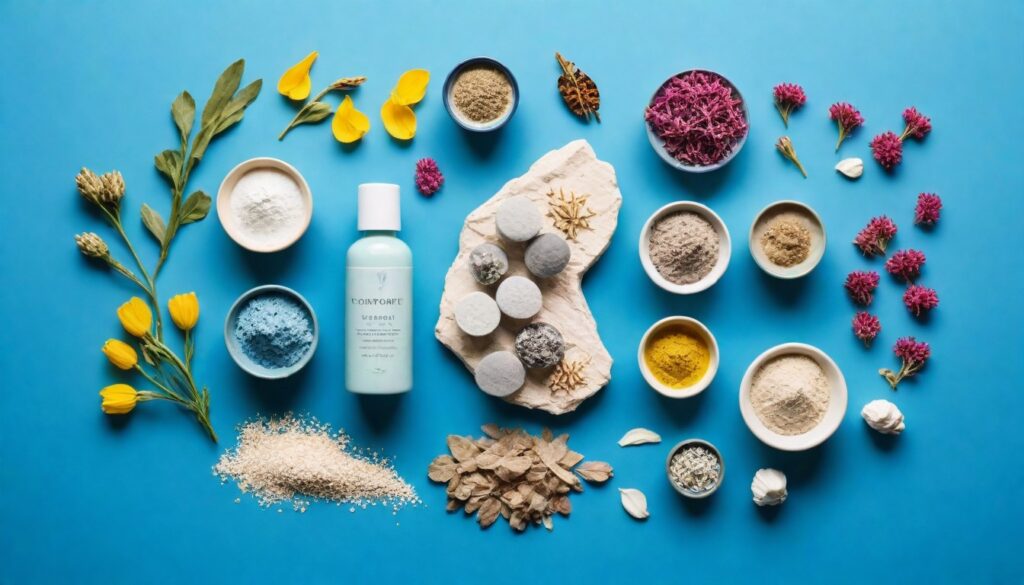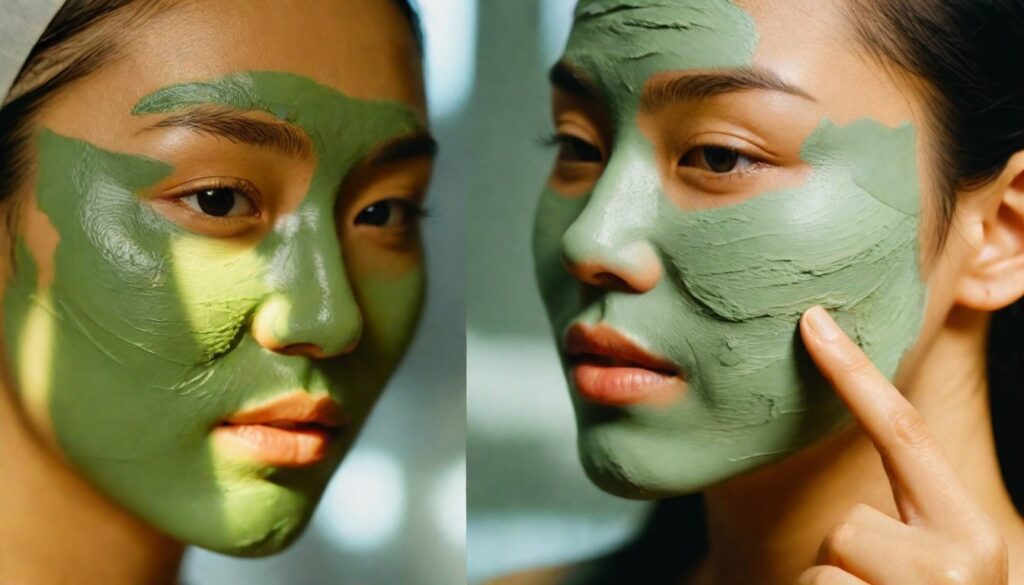Let’s talk clay masks today! 敷面膜 (fū miàn mó) as they say in China, which literally translates to ‘敷’ (fū) apply, ‘面膜’ (miàn mó) mask. Basically, treating yourself to a spa-worthy glow, without the splurge.
Remember that time you scrolled through Instagram and saw your friend with a bright green or pink mask plastered all over their face? Yeah, that, my friend, is a clay mask in action. These masks have become a major skincare must-have, promising to suck out all the gunk from your pores and leave your face feeling squeaky clean.
From purifying pores to banishing pesky pimples, clay masks seem to do it all. And the best part? They come in a rainbow of colours and formulations, making skincare feel more like a spa day than a chore.
But here’s the thing: while clay masks are supposed to be pore ninjas, secretly battling blackheads and whiteheads, some people, especially with oily and acne-prone skin worry they might actually be clogging those very pores they’re trying to save! Can you believe it? So, the question on everyone’s mind is: can clay masks actually clog pores? That’s what we’re about to dive deep (pun intended) into today!
Table of Contents
Gooey Wonders: How Clay Masks Work Their Pore-Minimizing Mojo

So we’ve established that clay masks are like tiny vacuum cleaners for your face, but how exactly do they work their magic? If you haven’t been paying attention so far, now is the time to Drop What You’re Doing! because we’re about to get schooled on the science behind these superstar masks!
There’s Clay, and Then There’s Clay
Not all clays are created equal! Just like your BFF might have a different favourite ice cream flavour than you, there are different types of clay suitable for various skin types. Here’s a quick rundown of the most popular ones:
- Kaolin Clay: This gentle giant is perfect for sensitive skin. It absorbs oil without being too drying. Think of it as the oatmeal cookie of clays – comforting and familiar.
- Bentonite Clay: This MVP is known for its serious oil-absorbing abilities. It’s ideal for oily or acne-prone skin, but remember, with great power comes great responsibility (think Spiderman). Don’t overdo it with this one! ️
- French Green Clay: This all-arounder is great for most skin types. It helps draw out impurities and tighten pores, leaving your skin feeling refreshed and smooth. Basically, it’s the Wonderwoman of clays, ready to tackle whatever your skin throws its way!
- Australian Pink Clay: This multitasking marvel is a gentle yet effective choice for many skin types. Think of it as the pretty in pink option. It can help draw out impurities, reduce redness, and leave your skin feeling soft and radiant. It’s especially kind to dry, sensitive, or mature skin.
Ingredient Insight: Identifying pore-friendly additives in clay masks
Now that we’ve got our clay base sorted, let’s talk about the extras – aka, the pore-friendly additives that take your clay mask game to the next level! Here are a few key ingredients to keep an eye out for:
- Charcoal: This powerhouse ingredient works hand in hand with clay to draw out impurities and detoxify the skin. Say goodbye to blackheads and hello to a clearer complexion!
- Hyaluronic Acid: Don’t let the word “acid” scare you – hyaluronic acid is actually a hydrating hero! This ingredient helps plump up pores and minimize their appearance by attracting and retaining moisture in the skin.
- Tea Tree Oil: Known for its antibacterial properties, tea tree oil is the perfect addition to clay masks for acne-prone skin. It helps kill acne-causing bacteria and soothe inflammation, leaving you with a clearer, calmer complexion.
Know Your Clay!
Before choosing a clay mask, take a moment to identify your skin type. Oily or acne-prone? Bentonite clay might be your bestie. Sensitive? Kaolin clay is your gentle hug. For a balanced approach, French green clay is a great choice!
The Gunk-Sucking Power of Clay
Now, here’s the cool part! The minerals in clay act like tiny magnets, attracting and absorbing excess oil, dirt, and dead skin cells sitting on your skin’s surface. Imagine all that gunk as those pesky villains your favourite protagonist needs to defeat. The clay swoops in and whisks them away, leaving your pores squeaky clean and ready to breathe!
Exfoliation Station
As a clay mask dries, it creates a gentle tightening effect. This helps loosen up dead skin cells and other debris, allowing the clay to absorb them even more effectively. It’s basically like a mini exfoliation boot camp for your face, buffing away dullness and revealing a brighter, smoother complexion underneath.
Tip: Less is More! While it’s tempting to leave your clay mask on for hours (hello, Netflix marathon!), resist the urge. Over-drying can irritate your skin. Follow the instructions on the mask and stick to the recommended time limit.
Struggling with irritated, over-exfoliated skin? My article here offers 6 calming solutions to soothe and repair your skin barrier plus a perfect exfoliation schedule for oily skin types!
Clay Masks: Pore BFFs or Foes?

Alright, so we’ve seen how clay masks work their magic, sucking out impurities and leaving your skin feeling refreshed. But here’s the question that keeps everyone up at night (well, maybe not literally): can these pore-minimizing wonders actually clog your pores?
The Pore Plight Debate: Addressing Common Misconceptions
So, you’ve probably heard whispers about clay masks being pore-clogging nightmares. But hold your horses! Before you swear off these magical masks forever, let’s debunk some of these common misconceptions:
- Myth #1: Clay Masks Suffocate Pores: Contrary to popular belief, clay masks actually work wonders for your pores. They help to absorb excess oil and impurities, leaving your pores cleaner and clearer than ever before.
- Myth #2: Clay Masks Cause Breakouts: Sure, you might experience a few tiny bumps after using a clay mask for the first time but fear not! This is simply your skin purging all the gunk trapped deep within your pores. Stick with it, and you’ll be rewarded with a glowing complexion in no time.
Pore Physiology 101: Exploring the nature of pores
Now, let’s talk pores. These tiny openings on your skin might seem innocent enough, but they’re actually quite the troublemakers. You see, pores have a tendency to get clogged with all sorts of nasties like dirt, oil, and dead skin cells. And this is where clay masks swoop in to save the day!
- Pore Size Matters: Contrary to popular belief, pore size is largely determined by genetics. While you can’t shrink your pores, you can definitely keep them clean and clear with the help of regular clay mask treatments.
- Pore-Clogging Culprits: From pollution to makeup residue, our pores face a daily onslaught of pore-clogging villains. But fear not! A weekly clay mask session can help banish these baddies for good.
Clay Masks: Pore Party Champs!
Let’s relax for a sec. Clay masks are actually superstars when it comes to keeping your pores clear. Here’s how:
- Bye-Bye Pore Blockers! Clay’s natural absorption powers act like a magnet, attracting and removing excess oil, dirt, and dead skin cells that can clog your pores. Think of it as a tiny night watchman for your face, cleaning up all the mess that can lead to blackheads and whiteheads.
- Minimizing Those Pores! As the clay dries, it has a gentle tightening effect. This helps shrink the appearance of pores, leaving your skin looking smoother and more refined. It’s like a temporary pore Photoshop – don’t worry, it’s the good kind of Photoshop!
Don’t Skip the Moisturizer!
Clay masks can be mattifying, which is great for oily skin. But remember, even oily skin needs hydration! Apply a lightweight moisturizer after using a clay mask to keep your skin balanced and happy.
Uh Oh, Clay Mask Mayhem? ️
While clay masks are generally good for pores, there are a few things that can go wrong:
Over-Exfoliation Station
Clay masks have a mild exfoliating effect. This is a good thing! But like anything good, too much can be bad. Over-exfoliation can irritate your skin and disrupt its natural oil production.
Oil Overload! ️
When your skin’s natural oil production gets messed up, it can go into overdrive to compensate. This excess oil can mix with dead skin cells and clog your pores. So, the key is to find the balance!
Wrong Clay, Wrong Time?
Just like picking the perfect outfit, choosing the right clay for your skin type is important. Using harsh clay on sensitive skin can be too drying, while gentle clay might not be strong enough for oily skin.
Tip: Patch Test First! Before slathering a clay mask all over your face, do a patch test on a small area like your jawline. This way, you can see how your skin reacts before committing to a full-on clay facial.
Clay Mask Mastery: Keeping Those Pores Happy

So, we’ve learned that clay masks can be amazing for your pores, but there are a few things to keep in mind to avoid any clogged pore drama. Let’s break down how to use clay masks like a pro and keep your skin glowing!
How Often Should You Clay Mask?
This depends on your skin type, my friend! Oily gals and guys might be able to handle a clay mask party 2-3 times a week. For dry or sensitive peeps, once a week is plenty. Listen to your skin – if it feels tight or irritated, take a break from the clay!
Know Your Skin, Choose Your Clay!
Remember that different clays are suited for different skin types. Oily skin? Bentonite clay is your oil-absorbing bestie. Dry skin? Kaolin clay is your gentle friend. For a balanced approach, French green clay is a great choice!
Preparation Protocols: Preparing the skin for optimal clay mask application
Before you dive headfirst into your clay mask session, it’s essential to lay down some groundwork to ensure maximum efficacy and minimal irritation. Here’s how to prep your skin like a pro:
- Cleanse Thoroughly: Start by washing your face with a gentle cleanser to remove any dirt, oil, and makeup lingering on the skin. This will help the clay mask penetrate deeper and work its magic more effectively.
- Exfoliate Gently: If your skin is feeling a little rough around the edges, consider exfoliating before applying your clay mask. This will slough away dead skin cells, allowing the mask to target pore-clogging impurities better.
- Steamy Situation: For an extra pore-purging boost, indulge in a steam treatment before applying your clay mask. Simply hold your face over a bowl of hot water for a few minutes to open up your pores and prep them for deep cleansing.
Feeling lost in the cleanser aisle? This two-part guide is your key to clearer, happier skin! We unveil the secrets of oil cleansers (check it out here) and foaming cleansers (read more here) for oily complexions!
Clay Mask Application: A Recipe for Success
Now, let’s get down to the nitty-gritty (pun intended) of applying your clay mask. Here’s how to do it right:
- Cleanse your face to remove any makeup, dirt, or oil.
- Apply a thin, even layer of the clay mask to your face, avoiding your eyes and lips.
- Relax! Chill for 10-15 minutes, but don’t let the mask dry completely. You don’t want your face feeling like a mummy mask!
Tip: Less is More! While it’s tempting to leave your clay mask on for hours (hello, Netflix marathon!), resist the urge. Over-drying can irritate your skin. Follow the instructions on the mask and stick to the recommended time limit.
Tired of makeup removers leaving your oily skin feeling irritated and clogged? This guide reveals 7 surprising tricks for removing makeup naturally! Read more here!
Clay Mask Removal: The Gentle Touch
Here’s how to remove your clay mask without scrubbing or irritating your skin:
- Wet your fingertips and gently massage the mask in circular motions to loosen it up.
- Rinse your face with lukewarm water, removing all traces of the clay.
- Pat your face dry with a soft towel. Don’t rub!
Pore-Pampering Practices
Congratulations, you’ve conquered the clay mask! But wait – your pore-pampering journey doesn’t end there. But remember, even oily skin needs hydration! Here’s how to keep those pores in tip-top shape even after you’ve rinsed off the mask:
- Hydrate, Hydrate, Hydrate: After removing your clay mask, be sure to moisturize your skin to replenish lost hydration. Opt for a lightweight, non-comedogenic moisturizer to prevent pore congestion without weighing down your skin.
- Cool Down: If your skin is feeling a bit red and irritated post-mask, soothe it with a cool compress or a spritz of facial mist. This will help calm inflammation and minimize any discomfort.
- Don’t Forget SPF: Last but certainly not least, always remember to apply sunscreen after using a clay mask. Your freshly cleansed pores are more susceptible to sun damage, so protect them with a broad-spectrum SPF to maintain pore health and prevent premature ageing.
Sun protection is vital, but who wants a greasy mess on their face? In this guide, I reveal the 10 greatest hits of sunscreens specifically formulated for oily skin. Check it out here!
Final Thoughts
Phew! We’ve dived deep into the world of clay masks, from their pore-minimizing magic to how to use them like a skincare superhero. So, can clay masks clog your pores? The answer is a resounding NOPE, not if you use them correctly!
Here’s the gist: Clay masks themselves are actually pore ninjas, battling blackheads and whiteheads by sucking out all the gunk that can clog them. But like any powerful tool, using them the wrong way can lead to trouble. The key is to choose the right clay for your skin type, apply it wisely (no mummy mask situation!), and moisturize afterwards to keep your skin happy.
So, there you have it! With a little know-how, you can harness the power of clay masks for clearer, smoother, and oh-so-glowy skin. Now, the only question that remains is: will your significant other be totally confused by your newfound obsession with putting dirt on your face? (Maybe it’s time to educate them on the wonders of clay!)
Frequently Asked Pore-ific Questions!
Conquered the clay mask basics, but still have some lingering questions? No worries, pore-fectly normal! Let’s dive into some commonly asked questions about clay masks and clogged pores:
Q: I have dry skin. Can I still use clay masks?
A: Absolutely! While clay masks are often associated with oily skin, there are gentle options like kaolin clay that can work wonders for dry skin too. Just be sure to moisturize well after using a clay mask, no matter your skin type!
Q: How long should I leave a clay mask on?
A: This depends on the specific mask, but generally 10-15 minutes is a good rule of thumb. Don’t let the mask dry completely – you don’t want to zap all the moisture out of your skin!
Q: My skin feels irritated after using a clay mask. What should I do?
A: If your skin feels red, itchy, or uncomfortable after using a clay mask, it might be a sign of irritation. Stop using the mask immediately and soothe your skin with a gentle moisturizer. If the irritation persists, consult a dermatologist. Remember, it’s always better to be safe than sorry!
Q: Are there any other ways to keep my pores clean besides clay masks?
A: Clay masks are a great option, but there are other ways to keep your pores happy! Chemical exfoliants, cleansing brushes, and even certain toners can help remove dirt and dead skin cells that can clog pores. Do your research and find what works best for your skin!
Q: Can clay masks help with blackheads?
A: Yes! Clay masks can help draw out the gunk that can lead to blackheads. However, they won’t permanently banish them. For stubborn blackheads, consider consulting a dermatologist for professional extraction.
Q: Should I let the clay mask dry completely before washing it off?
A: This is a big misconception! While clay masks do need some time to work their magic, letting them dry completely can actually be counterproductive. Completely dry clay can be harsh and irritating to your skin. The ideal state is for the clay to be mostly dry, but still slightly tacky to the touch. This way, it will absorb impurities without sucking out all the moisture from your skin.



Leave a Reply